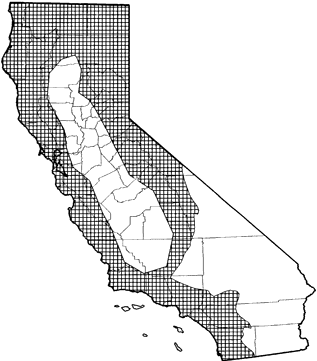
Long-eared Myotis
Distribution, Abundance, and Seasonality
The long-eared myotis is widespread in California, but generally is believed to be uncommon in most of its range. It avoids the arid Central Valley and hot deserts, occurring along the entire coast and in the Sierra Nevada, Cascades, and Great Basin from the Oregon border south through the Tehachapi Mts. to the Coast Ranges. This species has been found in nearly all brush, woodland, and forest habitats, from sea level to at least 2700 m (9000 ft), but coniferous woodlands and forests seem to be preferred.

Range Map
Specific Habitat Requirements
Feeding: The long-eared myotis feeds on a variety of arthropods including beetles, moths, flies, and spiders. It takes more beetles than other myotis species, and there is some evidence that it takes more beetles when it is sympatric with M. auriculus (Black 1974, Husar 1976). Insects are caught in flight, gleaned from foliage, or occasionally taken from the ground. Foraging flight is slow and maneuverable. This species is capable of hovering. It forages among trees, over water, and over shrubs. Usually less than 12 m (40 ft) above the ground.
Cover: This species roosts in buildings, crevices, spaces under bark, and snags. Caves are used primarily as night roosts. The long-eared myotis roosts singly, or is found in fairly small groups.
Reproduction: Nursery colonies of 12-30 individuals are found in buildings, crevices, snags, and behind bark.
Water: This species has a relatively poor urine concentrating ability, and probably requires water (Geluso 1978).
Pattern: Feeds along habitat edges, in open habitats, and over water.
Species Life History
Activity Patterns: Nocturnal. Hibernates. The long-eared myotis emerges late in the evening. Little is known of its winter habits.
Seasonal Movements / Migration: Probably makes local movements to suitable hibernacula.
Home Range: No data found.
Territory: No data found.
Reproduction: Mating probably occurs in the fall. The young are born from May-July, with a peak in June. The single yearly litter averages 1 young. Most young are flying by early August. The maximum recorded longevity is 22 yr (Tuttle and Stevenson 1982).
Niche: The long-eared myotis takes more beetles than most myotis species, especially when M. auriculus is present (Husar 1976).
Sources & References
California Department of Fish and Game, 1999.
California's Wildlife, Sacramento, CA.
Written by: J. Harris, reviewed by: P. Brown, edited by: S. Granholm, R. Duke
Albright, R. 1959. Bat banding at Oregon Caves. Murrelet 40:26-27. Barbour, R. W., and W. H. Davis. 1969. Bats of America. Univ. of Kentucky Press, Lexington. 286pp. Black, H. L. 1974. A north temperate bat community: structure and prey populations. J. Mammal. 55:138-157. Dalquest, W. W. 1948. Mammals of Washington. Univ. Kans. Publ., Mus. Nat. Hist. 2:1-444. Findley, J. S., A. H. Harris, D. E. Wilson, and C. Jones. 1975. Mammals of New Mexico. Univ. New Mexico Press. Albuquerque. 360pp. Geluso, K. N. 1978. Urine concentrating ability and renal structure of insectivorous bats. J. Mammal. 59:312-323. Hall, E. R. 1946. Mammals of Nevada. Univ. California Press, Berkeley. 710pp. Husar, S. L. 1976. Behavioral character displacement: evidence of food partitioning in insectivorous bats. J. Mammal. 57:331-338. Ingles, L. G. 1949b. Hunting of the bat, Myotis evotis. J. Mammal. 30:197-198. Jones, C. 1965. Ecological distribution and activity records of bats of the Mogollon Mountains area of New Mexico and adjacent Arizona. Tulane Studies Zool. 12:93-100. Manning, R. W., and J. K. Jones, Jr. 1989. Myotis evotus. Mammal. Species No. 329. 5pp. Sumner, L., and J. S. Dixon. 1953. Birds and mammals of the Sierra Nevada. Univ. California Press, Berkeley. 484pp. Tuttle, M. D., and D. Stevenson. 1982. Growth and survival of bats. Pages 105-150 in T. H. Kunz, ed. Ecology of bats. Plenum Publ. Co., New York. 425pp. Vaughan, T. A. 1966. Morphology and flight characteristics of molossid bats. J. Mammal. 47:249-260. Whitaker, J. O., Jr., C. Maser, and L. E. Keller. 1977. Food habits of bats of western Oregon. Northwest Sci. 51:46-55. Whitaker, J. O., Jr., C. Maser, and S. P. Cross. 1981. Food habits of eastern Oregon bats, based on stomach and scat analyses. Northwest Sci. 55:281-292.
California Animal Facts | California's Wildlife